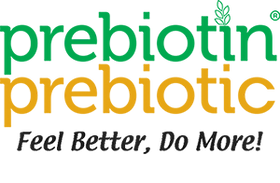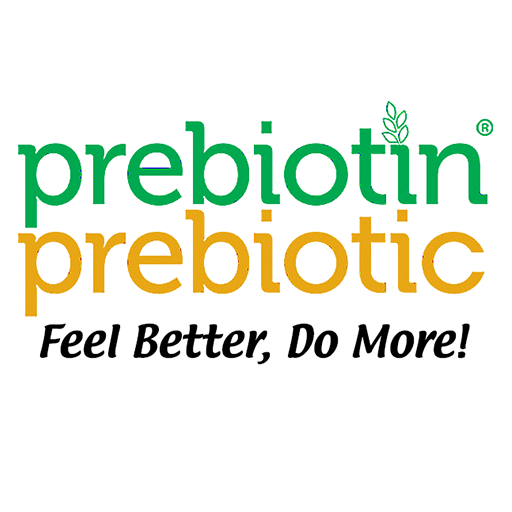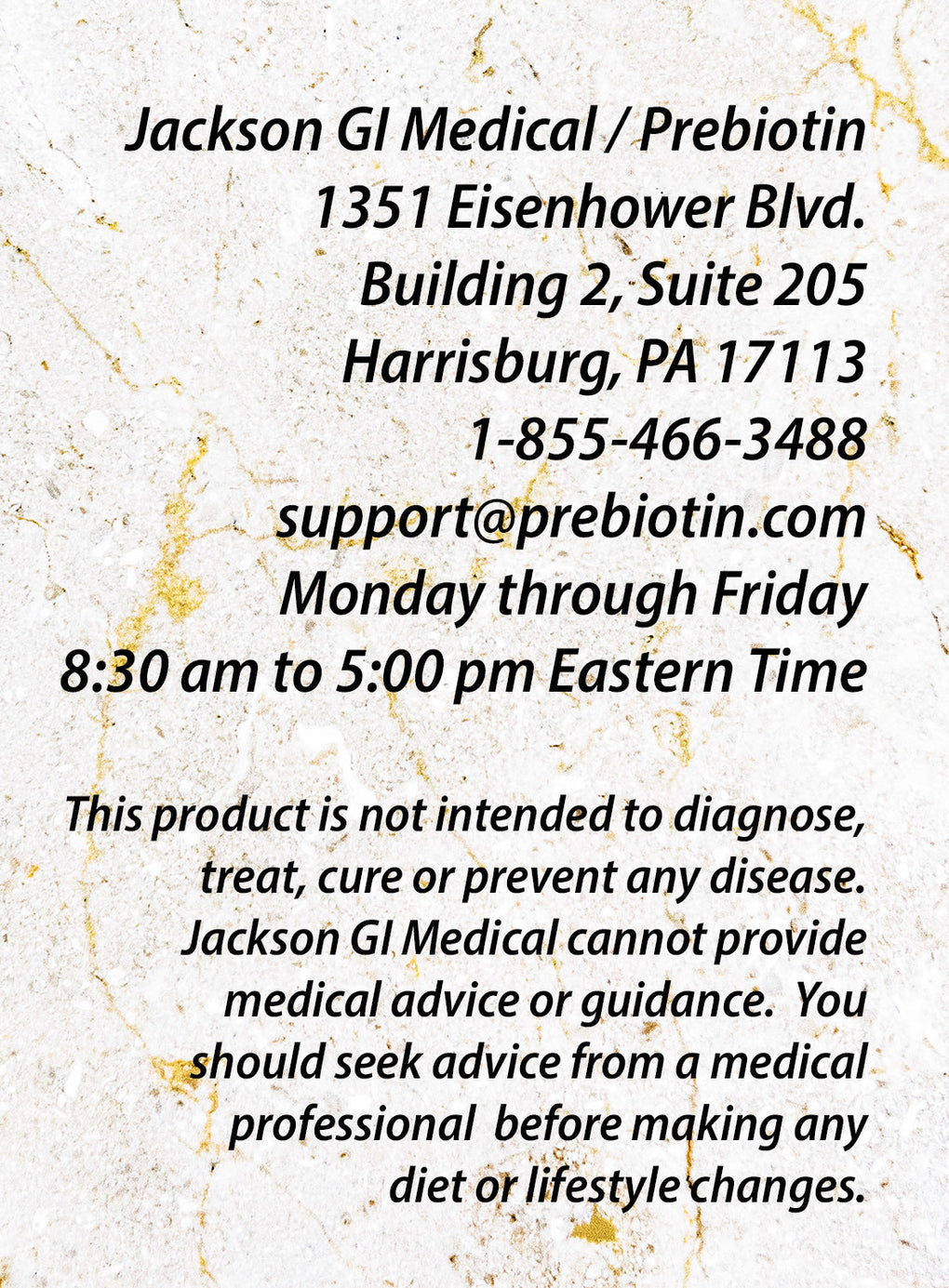
by Dr. Frank Jackson
Prebiotin Academy
Medical Concerns, Scientific Research and Diets
Celiac Disease and Gluten Intolerance
Resources on this page:
The Facts
Celiac disease is caused by a disorder in the body’s immune system. The food protein gluten interacts with the lining of the small intestine causing inflammation and damage. Gluten is found in wheat, rye, and barley. It may also be present in some preparations of oats. The lining of the small bowel is where all nutrients, vitamins, and minerals are absorbed in the body. This immune inflammatory reaction at this site can cause many problems but they all are a result of the inability of the small intestine to absorb these nutrients. The symptoms may include abdominal discomfort or pain, weight loss or inability to grow, change in bowel pattern such as constipation and diarrhea and symptoms in the brain, nervous system, bones, liver and other organs. While the disorder is genetically transmitted it does not always show up in childhood. It can present itself in adult life.
Here are some of the problems that may occur in the Celiac patient:
- Reflux of acid into the esophagus
- A skin condition called dermatitis herpetiformis with itching and blisters
- Anemia or low red blood count
- Headaches
- Fatigue
- Osteoporosis and weak bones
- Numbness, burning and tingling in the feet and/or hands
- Arthritis
Genetics
Over 1000 thousand years ago a person living in northern Europe had a gene mutation in the immune system. This resulted in the individual and many of his or her subsequent offspring having the genes necessary to have Celiac disease. It is the reason the people with a genetic background from northern Europe have a higher incidence of Celiac disease. In addition, it was at this time that wheat was being domesticated and considerable gluten from wheat entered the human diet. But it remained until World War ll when some chronically ill Dutch children were living in a famine and had no wheat to eat. They actually got better. When wheat was introduced into their diet after the war, they became sick again. It was soon found that wheat gluten was the culprit. It is known that if a person has the gene for Celiac, then a close blood relative will frequently have this abnormal antibody and will develop this disease.
The Immune System
We all begin to develop our immune system the day we are born when mother’s bacteria reach our colon and generate a strong immune system that protects us from infections our entire life. However, the immune system can overreact and be a problem in and of itself. Type 1 diabetes, rheumatoid arthritis, and lupus are just a few of the disorders that involve dysfunction of the immune system. Celiac, too, involves the immune system. When gluten comes in contact with the lining of the small bowel, Celiac patients have an inflammatory reaction that badly damages the lining and leads to all the medical problems that are known to occur. If you have one immune-related disorder, then it is more likely that you will get Celiac disease.
Celiac in Childhood
As noted Celiac disease often does not show up in childhood. When it does, many of these children are often overweight. While they may have a variety of digestive symptoms, some of them have none. Infants may experience failure to thrive, a swollen abdomen, abdominal discomfort, and diarrhea. Older children also may show a failure to develop or grow normally, changes in bowel patterns, late onset of puberty and mental changes such as attention deficit disorder and learning problems.
Untreated Celiac disease
Untreated Celiac disease can lead to serious medical problems. These include:
- Malnutrition. Various forms of poor nourishment may occur including anemia, vitamin deficiencies and failure to grow normally.
- Dermatitis herpetiformis. This is a blistering itchy condition of the skin that, fortunately, is responsive to diet and medications
- Osteoporosis and weak bones. This occurs because calcium and vitamin D are so poorly absorbed from the bowel.
- Infertility and miscarriage. Both of these may be present or occur in the female celiac patient.
- Lactose intolerance. Milk sugar is normally broken down by the enzyme lactase in the small bowel. This enzyme may be missing in this condition and the patient may have symptoms like bloating, gas and diarrhea when dairy products are eaten.
- Cancer. It is important that Celiac patients remain on a gluten-free diet. Otherwise, they are at risk for a serious form of bowel cancer called lymphoma.
A Gluten Free Diet
Wheat in all its forms is a basic part of the diet all over the world. Perhaps as many as 25% of the world’s calories come from wheat. So avoiding wheat and all its sources is a major task for the Celiac patient. Yet, it can be done as many Celiacs have stopped their disease dead in its tracks and now lead very healthy and productive lives. This section provides just an overview of a gluten free diet. To get the full diet in detail see the diet section of our Celiac Disease page. In the meantime, the following are where you can get help.
- Physician-your physician, ideally a gastroenterologist, has a great deal of information for celiac patients.
- Registered dietitian- Plan on spending at lease 2-3 sessions with this person. The dietitian will be the one who can provide basic information and tips on how to avoid gluten in the diet.
- Internet- there is now a large number of support groups for the Celiac patient on the web. Search them out. The larger ones are: National Foundation for Celiac Awareness and Celiac Support Association
- Local support groups your physician and her or his nurses will know of local support groups where you can exchange information and ideas. Become involved. It will pay off in your better health and give you satisfaction in helping others down the road.
Just to get you started, here are the common foods that have gluten and must be avoided:
- Wheat in all its forms
- Barley
- Rye
- Durum
- Farina
- Malt
- Graham flour
- Semolina
- Spelt
- Tricale
Be especially careful of packaged foods, sauces and soups. Wheat in many of its forms may be part of the ingredients. Read labels very carefully. If you don’t recognize a word, look it up before purchasing the food. Finally, most food stores now have gluten-free sections, which make shopping a lot easier. These foods are always a bit more expensive but until you learn to do-it-yourself, trust them.
Minerals and Vitamins
Your doctor will be checking you for deficiencies in minerals and vitamins. Ask the physician about:
- Iron
- Foliate
- Calcium
- Zinc
- Vitamin D
- Vitamin B-12
- Vitamin K
Poorly Responsive Treatment
Failure to respond to a gluten-free diet occurs in a minority of patients. This can occur for one of two reasons:
- Hidden gluten getting into your food. This is the first thing to check. Often a dietitian is helpful in finding the source of hidden gluten. The extra effort here is always worthwhile.
- Complicated immune disorders. At times Celiac disease is just one part of a more complex immune problem within the body. A gastroenterologist with extra training and experience in this field can often be helpful. Certain medications will sometimes be helpful in smoothing out such a complex situation.
Prebiotics
Prebiotics are a certain type of non-caloric carbohydrate found in many foods including wheat. It is separate from gluten. The technical names for these are inulin and oligofructose. These substances go through the gut unchanged and are then used by the best colon bacteria for their own growth. It is known that Celiac patients often have a bad bacterial mix, called dysbiosis. When the bad unwanted bacteria predominate and dysbiosis develops, a leaky gut can occur and allow toxins from the gut to enter the blood. Getting enough prebiotic foods is critical. 70% of the prebiotics that Americans eat come from wheat so when gluten and wheat are given up, prebiotics must be ingested from other sources. Prebiotics are plentiful in the following foods, which are also gluten-free:
- Onions
- Garlic
- Bananas
- Asparagus
- Avocado
- Yams
- Leeks
- Agave
- Artichoke
- Jicama
- Leeks
- Artichokes
- Most root vegetables
It may be worthwhile for a Celiac patient to use a prebiotic supplement such as Prebiotin.
Gluten Intolerance
It has recently been shown that there are a significantly large number of people who do not have Celiac disease with inflammation of the small bowel, but they do have an intolerance to gluten. This means that they just don’t feel good eating gluten containing foods and they often have a variety of abdominal symptoms such as bowel irregularity, gas, bloating and abdominal discomfort. They do not have inflammation in the gut nor are they prone to get true Celiac disease and its complications. It seems that these people often can consume some gluten without problems, which is not the case with a true Celiac patient.
Finally, there are now lots of younger people who have gotten on a gluten free diet just because it seems the thing to do and it might make a person feel better. There is nothing really wrong with this. However, it should be remembered that wheat is a terrifically nutritious food with lots of nutrients, vitamins, minerals and prebiotics, which feed the good bacteria in the lower gut. Many people who go on a gluten-free diet end up with a bad mix of gut bacteria because they are not ingesting enough prebiotics. Prebiotic-rich foods and/or a prebiotic supplement such as Prebiotin is recommended.
Diet
Surprising Facts About the Healthy-Gut Gluten-Free Diet
There’s a lot of talks today about gluten-free diets. Everywhere you turn, people seem to be raving about how a gluten-free diet has helped them lose weight and feel better. But do you need a gluten-free diet to be healthy? And if you do embark on a gluten-free diet, what are the potential risks and rewards?
Gluten Defined
The term gluten refers to a specific protein found in wheat, rye, barley, and triticale, as well as related species of grains. Gluten proteins act like glue, giving bread and cereal products made from these grains their texture. While gluten isn’t essential for health, many of the products made from grains containing gluten are a staple part of the American diet.
Celiac Disease, an Autoimmune Disorder of the Small Intestines
According to the University of Chicago’s Celiac Disease Center, approximately 1 out of 133 people are diagnosed with celiac disease. Your chances of being diagnosed with celiac disease jump when a close family member is also diagnosed with it. Celiac disease has a strong genetic component, with your chances of having the disease noted in the same study as 1 in 22 if a close relative has it, and 1 in 39 if an extended family member is diagnosed with celiac.
Celiac disease is an autoimmune disease that affects the small intestines or gut. When people with celiac disease eat foods containing gluten, their bodies’ immune systems mistakenly identify the chemical composition of gluten proteins as an invader in the body. The immune system is the defense against invaders — it’s how you ward off bacteria and viruses. In the case of people with celiac disease, the body sends out its attack force and targets the gluten proteins.
Over time, the villi — small, fingerlike projections lining the small intestines — become damaged. Villi help your body absorb nutrients from the food you eat during digestion. Because the villi are damaged, patients with celiac disease end up with a damaged small intestine, poor nutrient absorption, and related health problems, unless they address their celiac disease and alter eating habits.
If left untreated, people with celiac disease have a higher risk of developing other autoimmune diseases. The Celiac Foundation website states that untreated celiac disease may lead to the development of Type I diabetes, multiple sclerosis and a wide range of autoimmune disease.
How Is Celiac Disease Diagnosed?
Doctors may suspect celiac disease when patients present a range of symptoms including abdominal pain, bloating, discomfort, weight loss, fatigue, pale stools and more. Adults may have fewer digestive symptoms and more generalized autoimmune disease-like symptoms including weight loss, fatigue, joint pain and other symptoms. If your doctor suspects celiac disease, he or she may order a blood test called the tTG-IgA. Your doctor may also order genetic tests to screen for celiac disease.
Gluten Intolerance Test
What if you’ve made an appointment with your physician to discuss your symptoms and have undergone all of these tests only to test negative for celiac disease? Your body may still have trouble digesting gluten proteins or may have an allergy to wheat.
The Mayo Clinic states that testing for wheat allergies may include:
- Skin test, in which drops of purified wheat proteins are pricked into the skin. After 15 minutes, medical professionals examine the area for signs of an allergic reaction.
- Blood tests, looking for markers for various allergens.
- Elimination diets, which as the name suggests, eliminates suspected foods or food groups to see which makes someone feel better.
- Challenge diets, which “challenge” your body while under medical supervision to eat gradually increasing doses of a food suspected of causing reactions.
If you strongly suspect that gluten products are making you feel sick, you can eliminate them from your diet. As long as you continue to eat a healthy, well-balanced diet, eliminating wheat products should not cause any problems. You may also wish to consider supplementation with Prebiotin Prebiotic Fiber to support gut health. Since there’s no danger from eliminating gluten and adding Prebiotin Prebiotic Fiber to your daily diet, it may be worth exploring to see if you feel better.
Gluten-Free Diet Guide
Once diagnosed, your doctor or nutritionist will counsel you to follow a gluten-free diet plan. Such a diet plan omits all foods that contain gluten. You might think, “Well, that’s easy! I’ll just give up bread and crackers, and I’ll be fine.” Not so fast.
Although bread, crackers and other similar foods may indeed have gluten, food manufacturers use a wide range of gluten-based extracts to enhance the taste and texture of food. Remember that gluten is a binding agent, acting like glue. Many condiments include gluten as a thickening agent, for example.
While it’s almost impossible to list every possible food that contains gluten, it’s far easier to list gluten-free foods. A gluten-free food list contains an abundance of:
- Vegetables: Raw or Cooked, vegetables are a healthy part of the diet and gluten-free foods. Watch for frozen mixes that may contain added sauces and stick to plain vegetables or vegetable with homemade sauces.
- Fruit: Fruit in its natural state is a healthy blend of fiber, vitamins, minerals, and antioxidants. Avoid processed food products that lack nutrients and may contain added gluten.
- Starches: Stick with rice and potatoes, both of which are gluten-free. Oats used to be considered a gluten-based food since many people with celiac disease reacted to oats, but now they are thought to be generally safe for those with celiac disease as long as they are processed separately from wheat products.
- Meat and poultry: All types of meat and poultry are gluten-free and may be enjoyed as part of a healthy diet. Avoid breaded meats, since bread coatings may contain gluten.
- Fish: Tuna, salmon, shellfish … the list goes on of safe foods to enjoy. As with meats, avoid breaded or processed fish products such as fish sticks as the coating may contain gluten.
- Dairy products: Milk, yogurt, cheese and other dairy products may be safe to consume as long as they are not manufactured with gluten additives.
People following a gluten-free diet learn to be great label readers. Many products that you wouldn’t think contain gluten may have some wheat products or by-products in the mix. Some surprising products that can contain gluten include:
- Candy and chocolate
- Salad dressings
- Beer
- Self-basting turkeys
- Gravy
- Sauce mixes
- Pudding mixes
- Soy sauce
Look for the following names in the labels of prepared foods, as these words indicate the possible presence of gluten:
- Aracia, gum tragacanth, vegetable starch or xanthan gum
- Bean gum, cellulose gum, gum arabic, guar gum, locust bean gum
- Flour or cereals, except those made with flours from corn, potato, pure rice or soy
- Hydrolyzed Vegetable Protein (HVP), except those made from corn or soy
- Malt or Malt Flavoring, except those made from corn
- Modified Starch or Modified Food Starch, except those made from corn, arrowroot, tapioca, potato, maize or waxy maize
- Vegetable gum except those that are carob
- Vegetable protein except those made from soy or corn
- Soy Sauce or Soy Sauce Solids, unless the label specifically states it does not have any wheat
- Any of the following words on food labels often means that a grain containing gluten has been used:
- Stabilizer
- Starch
- Flavoring
- Emulsifier
- Hydrolyzed
- Plant protein
Your doctor or nutritionist can provide you with shopping guidelines to help you sort through the many choices at your local supermarket. Dining out while on a gluten-free diet may seem impossible, but patients with celiac disease quickly get the hang of reading through menus, making smart choices and asking for what they need from restaurant staff. Most are happy to comply with your requests for sauces on the side or food served without bread or gluten based condiments.
A Typical Gluten-Free Day
People with celiac disease who follow a celiac disease diet enjoy a wide variety of foods and beverages. A typical gluten-free diet menu may look like this:

As you can see, this is a healthy, tasty menu. It’s probably close to what you’re eating right now. By adding some simple prebiotic supplements to this menu, such as a serving of Prebiotin Prebiotic Fiber, you can include an additional boost of prebiotics to support gut health.
Gluten-Sensitivity Diets
A new trend emerging from celiac awareness is a gluten-sensitivity diet. This is what you see and hear about on the news as more and more people find they feel better without gluten in their diets. Although they do not have a genetic disease such as celiac disease, they find they feel better without gluten.
While there is nothing wrong with eating a gluten-free diet, care must be taken to preserve gut health while following a gluten-free diet. There are few drawbacks and many benefits from maintaining a gluten-free diet. Try eliminating likely suspects from your diet first and see how you feel, gradually eliminating gluten entirely if your doctor has ruled out celiac disease or wheat allergies.
For those who want to try a gluten-sensitivity diet on their own, follow the guidelines previously presented for celiac disease. Avoid all sources of gluten, including wheat, rye and barley products. Make sure you obtain healthy prebiotics through food sources such as onions and garlic as well as supplements. Eat a wide variety of gluten-free foods.
You may wish to track how you feel in a journal or diary so that you can monitor any effects on your health and share your findings with your doctor. If you are pregnant, nursing or suffer from any illnesses, you may wish to consult with a qualified health practitioner before adopting any significant dietary changes to ensure you receive adequate nutrition. Generally speaking, a well-balanced gluten-free diet that contains a wide range of fresh fruits, vegetables, dairy, poultry, seafood, meat and gluten-free grains is a healthy diet.
The Gut-Friendly Gluten-Free Diet
So far, we’ve talked about the health benefits of a gluten-free diet. People with celiac disease must follow a gluten-free diet in order to live a healthy, full life. Many people choose to omit gluten from their diets because they believe it makes them look and feel better. The basic food list of gluten-free foods reads like a guide to eating right: fruits, vegetables, unprocessed meats and dairy foods. But what do you lose when you lose the benefits of whole grains in the diet?
The Role of Prebiotics and Gut Health
Your intestines are teeming with bacteria. Good bacteria flourish throughout the colon, helping you ward off illness and even producing vitamins such as vitamin K. Bad bacteria are kept in check by the good guys, who outnumber the bad when you’re feeling well.
Like any living organism, bacteria thrives when it receives what it needs to stay healthy. To keep your gut bacteria healthy, a range of non-digestible food sources called prebiotics are needed. Prebiotics provide oligosaccharides — including inulins and their derivatives, the fructooligosaccharide. These compounds need to pass through the small intestine to the large in order to feed the hungry colonies of microbes living in the intestines.
Although the best sources of these compounds are derived from plants such as onions, leeks, garlic, and artichokes, most Americans get their prebiotics from cereal grains. And that’s where people on a gluten-free diet need to be careful since they omit most grain products.
Without prebiotics, the beneficial bacteria do not receive enough of the food sources they need to thrive. Digestion may suffer. The body may have trouble absorbing nutrients properly. It may also have trouble warding off bad bacteria such as E.coli when colonies of beneficial bacteria fall. What you eat directly and indirectly affects your overall health, including the health of your gut.
The health of your gut bacteria directly impacts your overall well-being, too, creating a cycle of interdependence that, if disrupted, can cause health problems. Therefore, people embarking on a celiac disease diet, gluten-free diet or leaky-gut diet that drastically reduces or omits all gluten-containing foods must be especially conscious of what they eat. They need to consider including supplementation to ensure they receive enough prebiotics in the diet.
Prebiotin Prebiotic Fiber
 In North America, 80% of the prebiotic fructans consumed come from wheat. When you eliminate wheat from your diet, you’re harming your gut microbiome. It’s important to replace this wheat with another source of prebiotic fiber.
In North America, 80% of the prebiotic fructans consumed come from wheat. When you eliminate wheat from your diet, you’re harming your gut microbiome. It’s important to replace this wheat with another source of prebiotic fiber.
Prebiotin is the perfect solution for people who feel better on wheat-free diets. As a supplement developed by Frank W. Jackson, M.D., it can also help patients who eliminate or avoid gluten in their diets receive enough prebiotics so their beneficial bacteria can flourish. Prebiotin Prebiotic Fiber is a naturally gluten-free supplement that supports health and immunity by providing gut bacteria with the beneficial materials they need to flourish.
Prebiotin Prebiotic Fiber differs from other fiber products in several ways. Unlike other supplements promoting prebiotic compounds, Prebiotin Prebiotic Fiber includes a range of prebiotic compounds that benefit multiple types of bacteria. Oligofructose-Enriched-Inulin (OEI) offers a full-spectrum prebiotic to address the broadest possible range of bacterial needs. OEI is well researched and has been used in both hospital and clinical studies.
Each serving of Prebiotin Prebiotic Fiber can be mixed into any liquid for easy consumption. The convenient serving scoop eliminates any guesswork about how much to use. Individually packaged servings are also available in a four-gram stick pack for those who want to take their prebiotics with them on the go. Even when you’re traveling, you can still enjoy the many benefits of Prebiotin Prebiotics Fiber.
At just 70 cents per serving, Prebiotin Prebiotic Fiber offers a simple way to follow a healthy gut bacteria diet. Even if you’ve been diagnosed with celiac disease, or you’re following a gluten-free diet, you can still receive all the benefits of prebiotics using this product.
Explore More
Medical Concerns, Scientific Research and Diets
-
Antibiotics and the Microbiome
-
C. Difficile
-
Calcium and Bone Density
-
Cancer
-
Celiac Disease and Gluten Intolerance
-
Children and Prebiotics
-
Colon Gas and Flatus
-
Colon Polyps and Cancer
-
Constipation
-
Crohn’s Disease
-
Diabetes Type 2
-
Diarrhea
-
Diverticulosis
-
Dysbiosis
-
End Stage Kidney Disease/Dialysis
-
Fatty Liver/Steatohepatitis
-
Fissure, Fistula and Abscess
-
Gut-Brain Connection
-
Heart and Cardiovascular
-
Hemorrhoids
-
High Fiber Diet
-
Immunity
-
Inflammatory Bowel Disease
-
Irritable Bowel Syndrome
-
Leaky Gut Syndrome
-
Low Fat Diet
-
Low Fiber Diet
-
Obesity and Weight Management
-
Toxins in the Colon
-
Ulcerative Colitis





